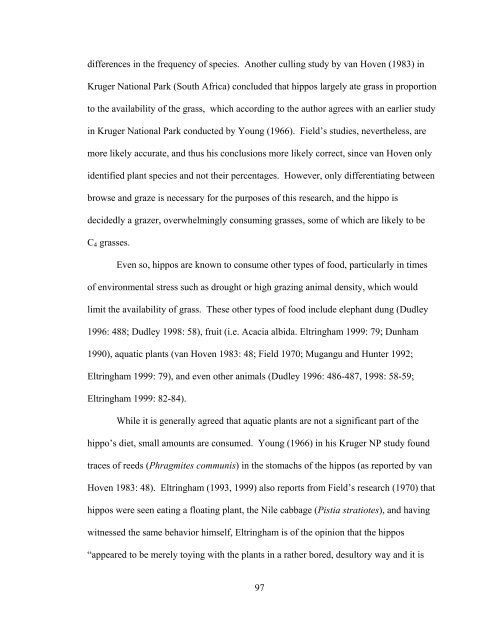Tracing the Source of the Elephant And Hippopotamus Ivory from ...
Tracing the Source of the Elephant And Hippopotamus Ivory from ...
Tracing the Source of the Elephant And Hippopotamus Ivory from ...
You also want an ePaper? Increase the reach of your titles
YUMPU automatically turns print PDFs into web optimized ePapers that Google loves.
differences in <strong>the</strong> frequency <strong>of</strong> species. Ano<strong>the</strong>r culling study by van Hoven (1983) in<br />
Kruger National Park (South Africa) concluded that hippos largely ate grass in proportion<br />
to <strong>the</strong> availability <strong>of</strong> <strong>the</strong> grass, which according to <strong>the</strong> author agrees with an earlier study<br />
in Kruger National Park conducted by Young (1966). Field’s studies, never<strong>the</strong>less, are<br />
more likely accurate, and thus his conclusions more likely correct, since van Hoven only<br />
identified plant species and not <strong>the</strong>ir percentages. However, only differentiating between<br />
browse and graze is necessary for <strong>the</strong> purposes <strong>of</strong> this research, and <strong>the</strong> hippo is<br />
decidedly a grazer, overwhelmingly consuming grasses, some <strong>of</strong> which are likely to be<br />
C4 grasses.<br />
Even so, hippos are known to consume o<strong>the</strong>r types <strong>of</strong> food, particularly in times<br />
<strong>of</strong> environmental stress such as drought or high grazing animal density, which would<br />
limit <strong>the</strong> availability <strong>of</strong> grass. These o<strong>the</strong>r types <strong>of</strong> food include elephant dung (Dudley<br />
1996: 488; Dudley 1998: 58), fruit (i.e. Acacia albida. Eltringham 1999: 79; Dunham<br />
1990), aquatic plants (van Hoven 1983: 48; Field 1970; Mugangu and Hunter 1992;<br />
Eltringham 1999: 79), and even o<strong>the</strong>r animals (Dudley 1996: 486-487, 1998: 58-59;<br />
Eltringham 1999: 82-84).<br />
While it is generally agreed that aquatic plants are not a significant part <strong>of</strong> <strong>the</strong><br />
hippo’s diet, small amounts are consumed. Young (1966) in his Kruger NP study found<br />
traces <strong>of</strong> reeds (Phragmites communis) in <strong>the</strong> stomachs <strong>of</strong> <strong>the</strong> hippos (as reported by van<br />
Hoven 1983: 48). Eltringham (1993, 1999) also reports <strong>from</strong> Field’s research (1970) that<br />
hippos were seen eating a floating plant, <strong>the</strong> Nile cabbage (Pistia stratiotes), and having<br />
witnessed <strong>the</strong> same behavior himself, Eltringham is <strong>of</strong> <strong>the</strong> opinion that <strong>the</strong> hippos<br />
“appeared to be merely toying with <strong>the</strong> plants in a ra<strong>the</strong>r bored, desultory way and it is<br />
97

















